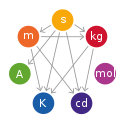Length
| Look up length, distance, width, or breadth in Wiktionary, the free dictionary. |
| Length | |
|---|---|
Common symbols | l |
| SI unit | meter (m) |
Other units | see unit of length |
| Extensive? | yes |
| Dimension | L |
Length is a measure of distance. In the International System of Quantities, length is any quantity with dimension distance. In most systems of measurement, the unit of length is a base unit, from which other units are derived.
In geometry, length is the most extended dimension of an object.[1]
Length may be distinguished from height, which is vertical extent, and width or breadth, which are the distance from side to side, measuring across the object at right angles to the length.
In theory, if a wire is cut but the direction in which length is defined is unchanged, it would be possible to cut a length of wire shorter than the wire's width.
Length is a measure of one dimension, whereas area is a measure of two dimensions (length squared) and volume is a measure of three dimensions (length cubed).
Contents
History[edit]
Measurement has been important ever since humans settled from nomadic lifestyles and started using building materials, occupying land and trading with neighbours.
Many units of length have been used throughout history and in different civilisations and cultures: until quite recently it was common for length units to be differently defined even between neighbouring towns and cities.
For instance one of the oldest units of length measurement used in the ancient world was the cubit, which was the length of the arm from the tip of the finger to the elbow. This could then be subdivided into shorter units like the foot, hand (which at 4 inches is still used today for expressing the height of horses) or finger, or added together to make longer units like the stride. The cubit could vary considerably due to the different sizes of people.
As trade between different places increased, the need for standard units of length increased. And later, as society has become more technologically oriented, much higher accuracy of measurement is required in an increasingly diverse set of fields, from micro-electronics to interplanetary ranging.[2]
Under Albert Einstein's special relativity, length can no longer be thought of as being constant in all reference frames. Thus a ruler that is one meter long in one frame of reference will not be one meter long in a reference frame that is moving relative to the first frame. This means the length of an object varies depending on the observer. However the effect is minuscule in normal circumstances: the length being inversely proportional to the square root of (1 minus the square of the ratio of the velocity of the object to the velocity of light). For a vehicle travelling at say 30 metres per second this would be a mere trillionth of one percent (10 to power -14) difference, and thus completely negligible.
Units[edit]
In the physical sciences and engineering, when one speaks of units of length, the word length is synonymous with distance. There are several units that are used to measure length. Historically, units of length may have been derived from the lengths of human body parts, the distance traveled in a number of paces, the distance between landmarks or places on the Earth, or arbitrarily on the length of some common object.
In the International System of Units (SI), the basic unit of length is the metre and is now defined in terms of the speed of light. The centimetre and the kilometre, derived from the metre, are also commonly used units. In U.S. customary units, English or Imperial system of units, commonly used units of length are the inch, the foot, the yard, and the mile.
Units used to denote distances in the vastness of space, as in astronomy, are much longer than those typically used on Earth and include the astronomical unit, the light-year, and the parsec.
See also[edit]
References[edit]
- ^ Princeton.edu
- ^ History of Length Measurement, National Physical Laboratory

